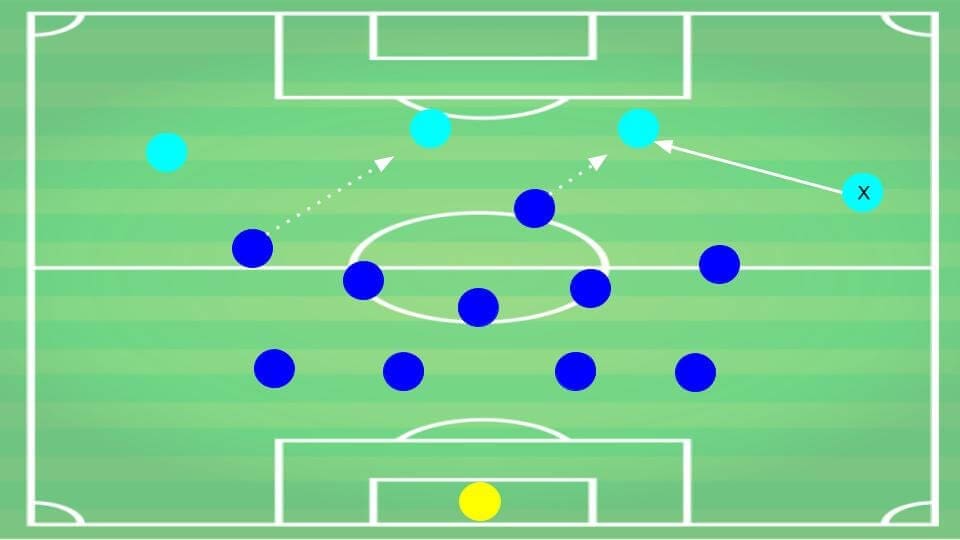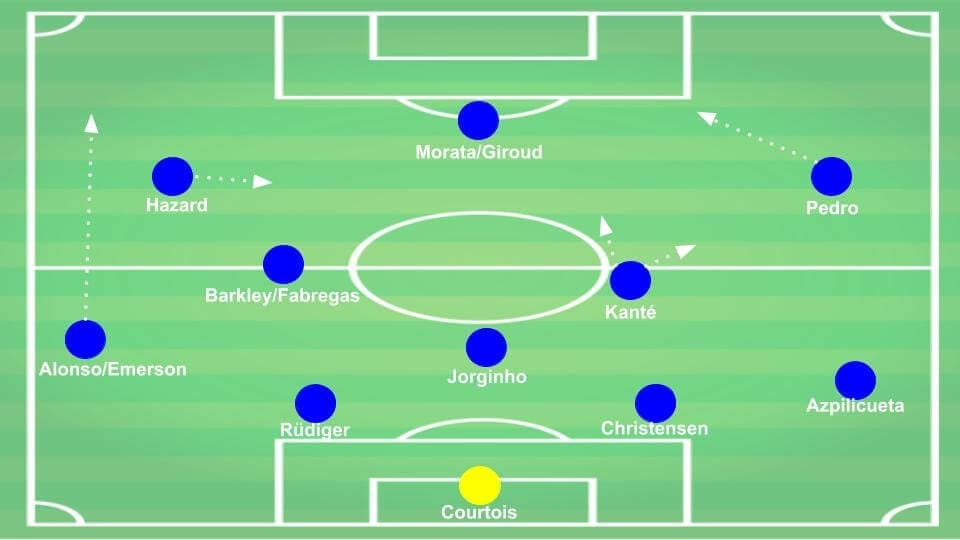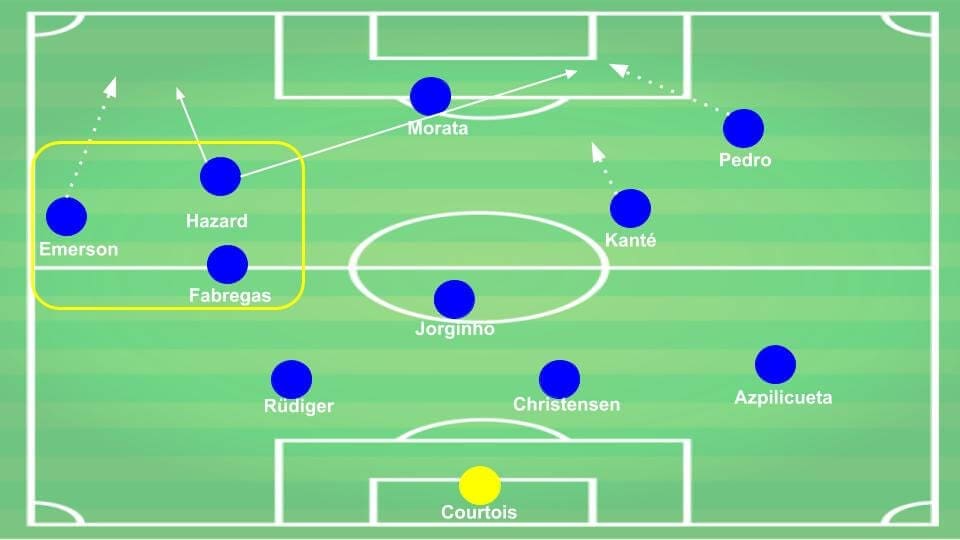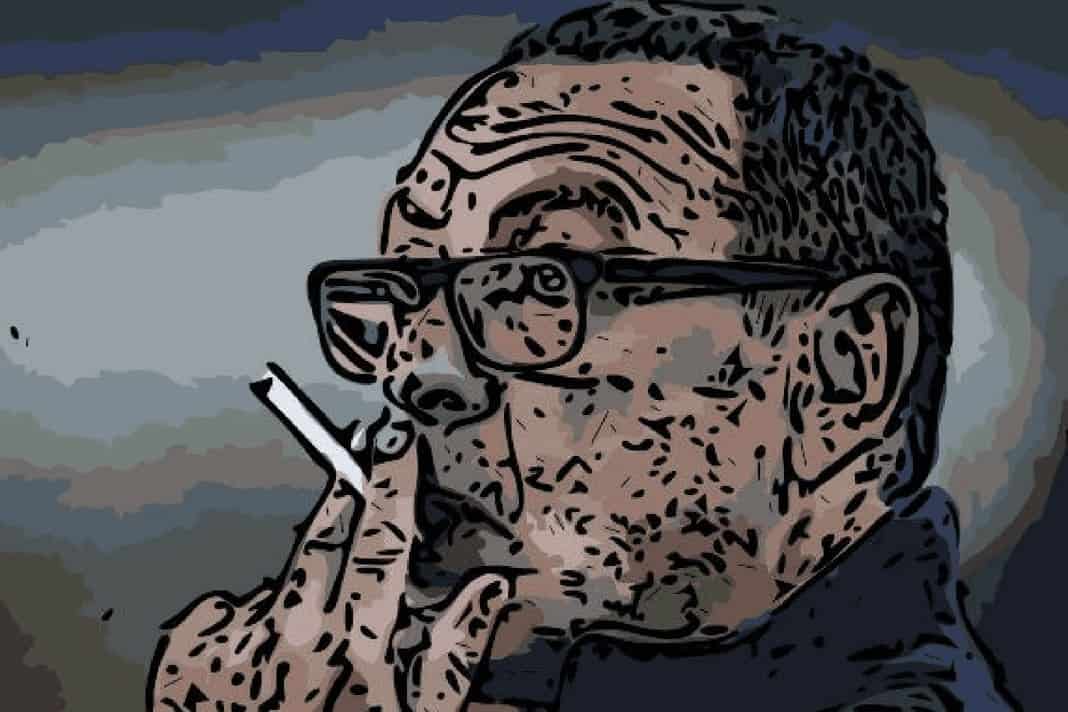Maurizio Sarri was confirmed as the new coach of Chelsea last week after months of speculation. Finally the club reached a deal with Napoli president Aurelio De Laurentiis. The deal brings not only one of Italy’s best coaches to England but also possibly the most exciting style of play in Europe. Over the last couple of seasons Sarri’s Napoli has really appealed to people across the continent. They’ve played brilliant football. Now it remains to be seen if Chelsea can too. This post will look at how Chelsea might set up under their new coach. I will broadly discuss the basis of Sarri’s style of play, which roles he wants his players to play, how Chelsea’s players fit into his setup and finally how a Chelsea team under Sarri might look. Ready? Let’s go.
Maurizio Sarri’s preferred style of play
Sarri is famous for the short-passing combinations you’ve seen clips of all over Twitter over the last few years. Like a few other Italian coaches, Sarri loves these types of passing combinations. His teams are always looking for triangles to utilise the concept of the third man whereas Player A will pass to Player B which attracts pressure and creates space for Player C as he receives a pass from Player B. Sound simple? It’s really not.
Sarri’s style isn’t based on possession for the sake of it, however. His Napoli did control possession for the majority of their games but the focus is always to move the ball forward quickly through the use of rapid one-touch passing. To accomplish this he needs his players to set up in a specific manner. The attacking structure of the side sees them line up in multiple horizontal lines with each player in close proximity to another. Obviously, you can’t play short-passing combinations if the players are 30 meters apart. By placing the players in different lines Sarri increases the possibility to move the ball forward at speed. For example, at Napoli, if the centre-back Koulibaly was in possession in the first line he could look for Marek Hamsik in the third. As Hamsik receives the ball he could lay it off to defensive midfielder Jorginho in the second who instantly could find striker Dries Mertens in the fourth. Mertens could then lay it off to the onrushing Hamsik who could spread it wide to the winger Insigne or an attacking full-back. Without the players occupying different lines, Hamsik would have been forced to go back to Koulibaly and it would have been easier to defend against. Now Napoli always managed to play within the opponent’s defensive structure which causes problems for every team.
In the final third, Sarri deployed a few distinct features. The most known is the movement of left-winger Insigne into the space between the lines before lofting a diagonal ball in-behind for the right-winger Callejon. This play caused problems because of how it attacked the weak side of the defending team after they had been forced to overload on Napoli’s left. Another way Napoli went about creating chances was by Insigne again moving inside to open up space down the left for left-back Faouzi Ghoulam who would then fire low, hard crosses into the space between the opponent’s defensive line and goalkeeper.
In defence Sarri has used a strictly positionally-orientated defensive system. This means the players move in unison according to the position of the ball and their teammates without paying attention to the positions of the opposition. This style of defending, if done right, gives the defending team control since they can largely decide where the attacking team are allowed to play. This makes this defensive style proactive, rather than the reactive nature of a man-orientated approach. Sarri’s teams also press high, with a lot of energy and intensity. In fact, their pressing has often been forgotten as it’s easier to appreciate their play in possession. But make no mistake, Chelsea will be tough to control possession against. At Napoli, Sarri played 4-5-1 in defence where one of the wingers would push up alongside the centre-forward to press. I’ve illustrated how this might look for Chelsea below.

Formation and roles
Sarri became a big name in Italy thanks to his superb work at Empoli with whom he won promotion to Serie A. His style of play was the same at Empoli as it later was at Napoli but he used a 4-3-1-2 in Tuscany. That formation, of course, is perfect for the type of short-passing combinations Sarri loves. When moving to Napoli he initially tried to instill the same formation but after some struggles and the fact Gonzalo Higuain worked better as a lone striker he changed to the 4-3-3 he’s used ever since. In England, given the huge wing-focus in the league, it’s unlikely he uses the diamond and instead continues with 4-3-3.
The roles in Sarri’s 4-3-3 at Napoli have been quite interesting. The goalkeeper has to be able to build from the back and be comfortable in possession as Napoli often restarted their attacks from the goalkeeper. He also needs a good kicking technique to loft passes out towards the full-backs to escape high-pressure. The two centre-backs need to be comfortable in possession as they are often in charge of initiating attacks and play passes through the lines of the opposition. Defensively they need to be very good in terms of positioning and have the pace to keep a high line. Sarri will work this extensively in pre-season, probably using a drone to film and correct the movements of his defenders. He used contrasting roles for his full-backs at Napoli; the left-back was always extremely attacking and linked up with the inverted movement of left-winger Insigne but the right-back often kept a more cautious position, remaining deep with the centre-backs to guard against counter-attacks. It will be interesting to see if this continues at Chelsea.
In midfield, Sarri loves a technically gifted passer at the base of his three-man midfield. He first brought Mirko Valdifiori with him from Empoli but then settled on Jorginho who he has now brought with him to Chelsea. This position is vital as this is the player who sets the tempo of the attacks and often plays the first line-breaking pass as Sarri’s team looks to go forward. Ahead of the deep-lying playmaker, Sarri will use a box-to-box player who presses high and breaks up play. In possession, this player will help attract pressure in midfield to open up the space between the lines before bursting forward into the box. On the left of the three Sarri used Hamsik at Napoli as a more advanced playmaker who was key in finding through-balls in the final third and often made movements into the box.
Sarri’s attack at Napoli had distinctive roles for each player. On the left, he used Insigne as a creator who moved inside between the lines and looked for through-balls to the striker or the lofted passes to Callejon I mentioned earlier. On the right, he used Callejon as a player who made clever diagonal runs in behind the defence and always became a threat at the back-post from the crosses from the left. The striker position changed in his time at Napoli; first, he had Higuain as a classic centre-forward who had the best ever goalscoring season in Italy and after he left he used Mertens as a false nine who dropped between the lines and became a part of the possession play. This is perhaps the most interesting role to keep an eye on at Chelsea with Morata and Giroud the alternatives. There’s also a move for Higuain speculated to materialise.
Possible Chelsea team with current players
At Napoli, signings have been forced to be patient to break into the team as Sarri wants each player to know his role very well before playing them. It will, therefore, be interesting to see how long it takes for him to transfer his ideas to a brand new squad of players. Expect plenty of rotation in some positions before he decides on who to use where. Based on his preferences at Napoli, I’ve compiled a possible Chelsea team though I’ve left some positions open with multiple options. I’ll explain each position below.

Defence – from five to four
Antonio Conte used a five-man defence almost exclusively in his time at Chelsea but Sarri will change this to a back-four. Cesar Azpilicueta is perfect for the more reserved right-back role. He will burst forward only when width is required. Marcos Alonso and Emerson will battle for the left-back slot where I think Emerson might edge the Spaniard. Emerson had a great season at Roma before injuries ruined his 2017/18 and could be a revelation under Sarri. It’s intriguing to see who Sarri prefers in central defence but I think Andreas Christensen and Antonio Rüdiger have a chance to be the long-term partnership given their quality on the ball and athleticism to maintain a high-line. Gary Cahill might start as first-choice given his familiarity with a positionally-orientated defence but all of the defenders should be aware of this style since Conte defends in a similar way albeit deeper. David Luiz doesn’t seem like a good fit, but neither did Vlad Chiriches in Naples.
Midfield – who will play where?
Given the signing of Jorginho and his comfort in Sarri’s style of play, it would make sense for him to start as the deep-lying playmaker. He knows what Sarri wants and his quality in possession is amazing. N’golo Kanté is perfect for the “Allan-role” as the right-sided midfielder given his tenacity and ball-winning qualities as well as the energy to get forward too. Kanté is a very clever player and it wouldn’t surprise me to see him bag a few goals next season. The left-sided position is the one up for grabs and there are a few options. Ruben Loftus-Cheek is one, Ross Barkley another but I think, at least initially, that Cesc Fabregas will be Sarri’s pick. Fabregas has previously played in a team (Barcelona) who moved the ball quickly and his intelligence in possession seems to fit well with Sarri’s style. Whether he has the energy required is up for debate though.
Attack – Hazard will be vital
In attack, it’s no surprise to think that Eden Hazard will be vital. He has been under four or five managers at Chelsea so it shouldn’t be different now. He will play the role of the left-winger who moves inside into the left half-space from where he will act as a creator looking to combine with the onrushing left-back or look for the lofted diagonal from the right-winger. Hazard will be fantastic to watch in this role.
On the right, it seems like Pedro and Willian are the main challengers and I expect Pedro to be given the nod. The Spaniard has experience of a similar role under Guardiola at Barcelona where he excelled with diagonal runs from the wing and if Sarri continues with this method then Pedro will be the perfect player. Willian could possibly be moulded into this role, but Pedro seems a better fit right now.
Up front I think Morata has the upper hand over Giroud simply because Chelsea won’t play many aerial balls which is often where Giroud excel. His link-up play along the ground is also great, but I think Morata’s deep runs will be preferred. The link to Higuain is exciting, given Higuain’s outstanding performance under Sarri in 2015/16. Below I’ve illustrated the type of movement we can expect to see from Chelsea next season. They will overload the left with three players before finding Hazard between the lines. He will then spray the ball wide left or diagonally right.

Conclusion
Maurizio Sarri brings with him a reputation for producing exciting football and has impressed at Napoli for three years. Some people have felt the need to criticise his lack of trophies, but those people forget that Sarri has worked in a club with finances not even among the top four in Italy. Still, Sarri has broken points record in back-to-back seasons. Unfortunately for him, Massimiliano Allegri’s Juventus has been historically good and managed to topple Napoli in each season. It will be vital for Chelsea to remember that Sarri’s style takes time to incorporate and early results might be negative. If they stick with him, however, Chelsea will witness the type of football they’ve wanted for years.
** ** **
Read more on Sarri here in this match analysis of his Napoli’s brilliant win at Juventus. I also recommend this piece on Ronaldo’s move to Juventus.





Comments